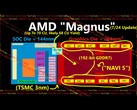In a recent interview, PlayStation hardware architect Mark Cerny revealed that RDNA 5, AMD’s next-generation GPU architecture, includes components developed in collaboration with Sony for its upcoming console, which is most likely to be the PlayStation 6.
The confirmation ties into Project Amethyst, AMD and Sony’s joint effort to build AI tools for gaming. Unveiled in late 2024, the project targets AI-driven upscaling, ray tracing, and frame generation.
As part of the initiative, both companies are developing convolutional neural network (CNN) models for image processing, designed to run across consoles, PCs, and the cloud. These are the same machine learning models often used in computer vision, they excel at making sense of images, which makes them a natural fit for tasks like upscaling and frame generation.
The first major result is FSR 4, AMD’s latest temporal upscaler, which will also serve as the foundation for an upcoming PSSR update on the PS5 Pro.
It’s being designed as a “drop-in replacement,” allowing devs to enhance existing games without overhauling rendering pipelines, a move similar to DLSS. Sony’s QA team helped fast-track Amethyst’s model tuning, reportedly shaving years off development. The work is now shaping PS6’s graphics pipeline and feeding into AMD’s broader GPU roadmap.
Cerny said RDNA 5 isn’t just AMD’s next step, it also folds in “engineering work we’ve been putting into the next-generation console,” hinting at a multi-year development arc that likely points to a PS6 launch sometime around 2027 or 2028.
Sony’s next-gen console SoC is reportedly already in pre-silicon validation, featuring a Zen 5 CPU and a UDNA GPU, likely a successor to RDNA 5. A handheld with a similar architecture is also rumoured to be in development, suggesting a unified AI-driven rendering pipeline across future PlayStation hardware.
Though unofficial, the details echo Sony and AMD’s growing focus on shared upscaling tools and hardware co-design.
Sony’s strategy appears to involve shipping PS5 Pro hardware to familiarise studios with ML-accelerated workflows ahead of the reportedly AI-heavy PlayStation 6 era. Cerny described the initiative as preparatory work, stating: “What I’m trying to do here is prepare for the next generation of consoles. So my timeframe is multi-year.”
Interestingly, AMD also clarified that the work being done with Sony is not proprietary, meaning parts of the technology could end up benefiting the wider PC and console gaming ecosystem.
For a deeper technical dive into what all this could mean for console graphics, Digital Foundry also weighed in on the evolving AMD–Sony partnership in their recent episode. You can watch the video below.






























